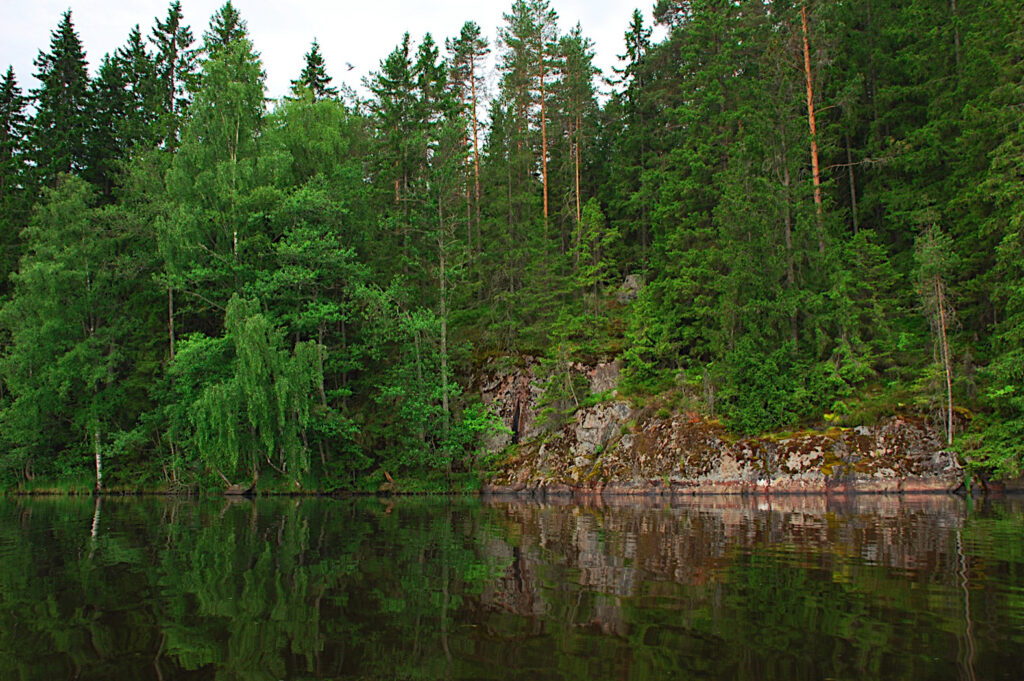
From Lake Ladoga to Lake Saimaa
In the “From Ladoga to Lake Saimaa” cooperation project, coordinated by the Finnish Association for Nature Conservation, shorelines and waterways are being restored to their natural state. Additionally, the project aims to develop sustainable recreational use of shoreline areas in the Käkisalmi region in Russia and the Hiitola River watershed area in Finland.
Project Info
Duration
1.4.2020–31.3.2022
Target area
Saimaa, Laatokka
Contact
Tuuli Hakulinen
About the Project
The Finnish Association for Nature Conservation is the lead partner and coordinator in a Finnish–Russian project, named ”The best practices of shoreline biodiversity protection” (From Lake Ladoga to Lake Saimaa), officially titled KS1771 Shore Protection.
In addition to the Finnish Association for Nature Conservation, the Hiitolanjoki Association is a project partner on the Finnish side. In Russia, project partners include the Directorate of the Protected Areas of the Leningrad Region, the Komarov Botanical Institute of the Russian Academy of Sciences, the non-governmental organisation Neo Eco Project and the Priozersk Municipality.
Objectives and Aims
The overall objective of the project is to maintain and preserve the freshwater reservoirs in the South-East Finland and the Karelian isthmus areas, as well as the sea, clean, and to attract tourists and new inhabitants with a pure and clean environment.
The main aims of the project include
- restoring shoreline and mire biotopes and water bodies in Finland and Russia
- developing and promoting sustainable recreational use of the shorelines in the Priozersk area in Russia and in the Hiitolanjoki River area in Finland
- creating an ecotrail in the Priozersk town
- preparing substantiations for a new state protected nature area ”Motornoe-Zaostrovie”.
Target Areas
The target areas of the project include
- mires at the shore areas in the South Karelia, South Savo and Kymi regions (Finland)
- the Hiitolanjoki River (Finland)
- the delta and grey dunes of the Volkhov River (Russia)
- the Priozersk town (Russia)
- Motornoe-Zaostrovie area (Russia)
Actions
In Finland
In Finland, ditching of mires causes a negative impact on the shoreline biodiversity and water ecosystems, and the mires have degraded as a result of extensive ditching. In the South Karelia, South Savo and Kymi regions, mires at the shore areas will be restored e.g. by planting sphagnum moss.
On the Hiitolanjoki River, novel water system biotope restoration methods will be tested. The method is based on wood material that is dumped in the water. Over time, e.g. bacteria, algae and fungi start to grow on the material, thus creating a biofilm that filters impurities, nutrients and metals from the water. In addition, the sunken wood offers habitat and shelter for various organisms and functions as a carbon sink.
The Hiitolanjoki River is a historically significant waterway, as it was the first waypoint from Lake Ladoga to inland Finland for ancient Karelians. Possible historical canoe routes will be examined by clearing the waterways and test canoeing the possible ancient routes on the Hiitolanjoki River basin and the headwaters of the river, all the way to Lake Saimaa.
In Russia
The Red-listed species Pulsatilla vulgaris is unique to the Russian Federation, and Volkhov is the habitat of a number of rare and vulnerable elements of biodiversity – including Pulsatilla vulgaris. A methodology for restoring grey dunes at the mouth of the river Volkhov and the Pulsatilla vulgaris habitat will be prepared and implemented.
Priozersk is famous for its cultural and historical heritage and attracts a lot of tourists on the coastal zones of Lake Ladoga and the Vuoksa River. An eco-trail will be constructed in Priozersk, by clearing and cleaning the shore areas, building the trail, and mounting the infrastructure, such as information stands, toilets, dustbins and benches, along the trail.
A new nature protected area ”Motornoe-Zaostrovie” on the shore of Lake Ladoga is currently in the ”planned” status in the Leningrad region land-use plan. The nature values of the area will be mapped, a field study will be conducted, and a formal paper will be prepared, which will favor the establishment of the protected area ”Motornoe-Zaostrovie”.
Jointly
In addition to the aforementioned activities, the best practices in each project pilot territory will be shared and disseminated through study visits and press tours to project areas, and by various means of communication. At the end of the project, the results and accomplishments will be presented to the public in an exhibition in Lappeenranta, South Karelia in Finland.
Duration and budget
The duration of the project is 1.4.2020–31.3.2022. The full budget of the project is 464 894 euros.
The project is part of the South-East Finland–Russia C
Results
In Russia, dunes and the habitat of the endangered Pasque flower (Pulsatilla vulgaris) are being restored in the Olhava River delta in northeastern Lake Ladoga.
Sustainable recreational use of shoreline areas is also being promoted on both sides of the border. In Finland, a historically themed wilderness paddling route is being planned from the headwaters of the Hiitola River all the way to Lake Saimaa. In Russia, a nature trail is being planned in the municipality of Käkisalmi, natural values are being mapped, and a conservation area proposal is being prepared for the Motornoe-Zaostrovie region, a designated nature reserve along the shore of Lake Ladoga.
Project Funding Partners
